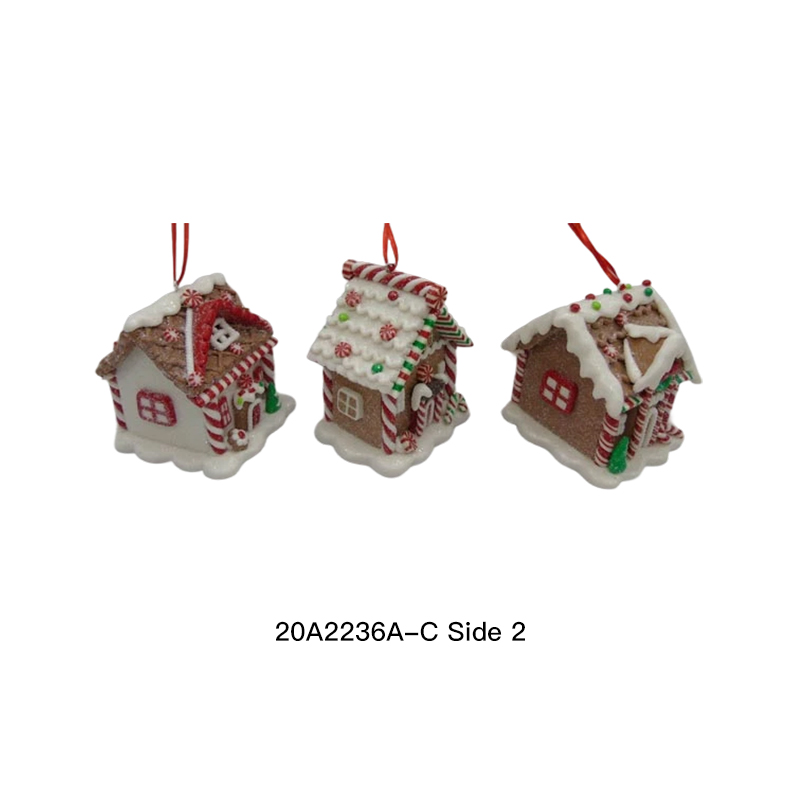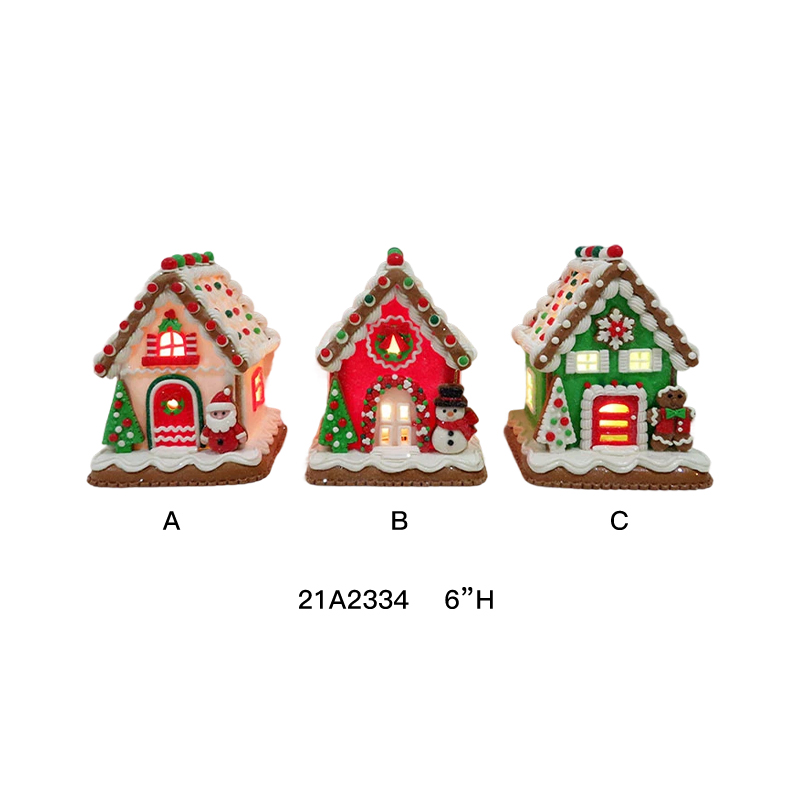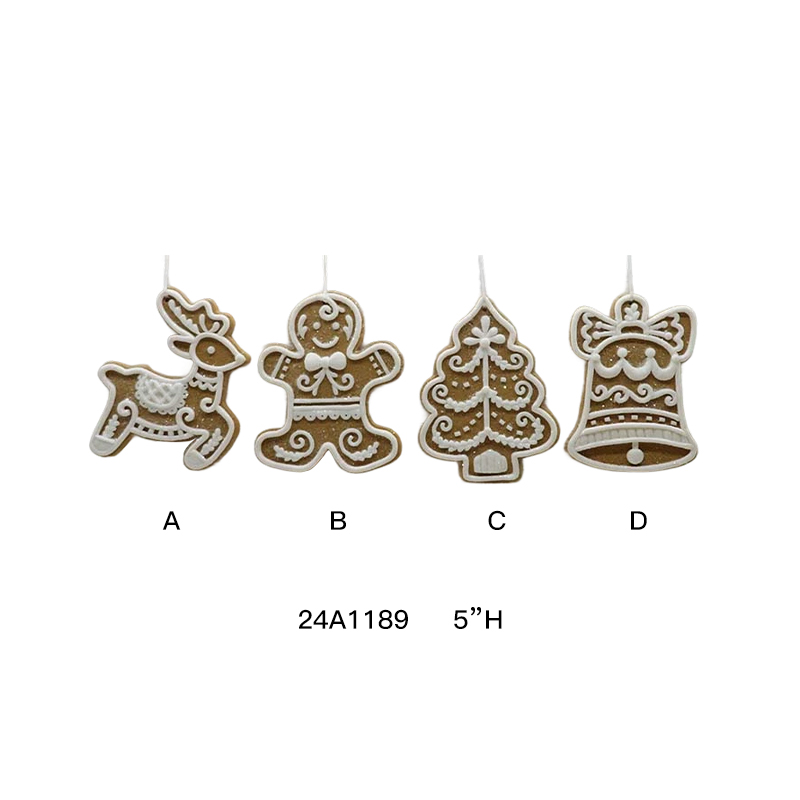How do realistic clay Christmas ornaments enhance the festive atmosphere?
Release Time : 2025-11-24
As the winter winds sweep through the streets, warm yellow lights illuminate shop windows, and Christmas trees are adorned with twinkling ornaments, people know that the most heartwarming and ritualistic holiday of the year is quietly approaching. Among the many elements that create a festive atmosphere, ornaments always play an indispensable role. Christmas ornaments are quietly gaining popularity: they are not DIY crafts, but finished works of art meticulously crafted by professional artisans. Their appearance closely resembles classic gingerbread houses, sugar cookies, and holiday candies, decorated with colorful "sugar granules," covered with delicate "icing," and using classic Christmas colors such as red, white, and green—so realistic that you almost want to take a bite. They are masterpieces of holiday decoration, embodying craftsmanship and meant to be treasured for a long time.

I. The Birth of Professional-Grade Clay Crafts
It is particularly important to emphasize that Christmas ornaments are finished products, from design and shaping to painting and assembly, all completed by experienced craftsmen in their workshops. Its core material is a specially made clay dough, which possesses excellent plasticity, fineness, and stability. After drying and hardening, it becomes hard, resistant to deformation, and highly replicates the texture and sheen of food surfaces.
The production process begins with meticulous hand-carving: artisans meticulously sculpt the three-dimensional outline of real gingerbread, candy canes, Christmas puddings, or miniature cakes using tools. Then, multiple layers of faux "icing" are hand-applied to the surface, controlling the thickness and flow to simulate the naturally flowing and solidified texture of icing. Finally, it is adorned with miniature "colored sugar beads," "chocolate shavings," and "powdered sugar sprinkles." Each "candy" is precisely positioned and fixed, ensuring overall visual harmony and a playful, childlike feel.
This extreme pursuit of detail far surpasses what ordinary home crafts can achieve, and it is precisely for this reason that these decorations possess artistic collectible value and long-term display potential.
II. Visual Magic: Why are they so realistic that they are "believed to be real"?
The key to the lifelike quality of these clay Christmas ornaments lies in the perfect fusion of three visual elements:
First, the classic reproduction of colors. Red, white, and green, the three primary colors of Christmas, are precisely applied to different parts: the bright red of berry-like sugar icing, the pure white of snow-like frosting, and the mint-green of pine needles. The colors are saturated yet not glaring, warm but not cloying, evoking collective memories of traditional holidays.
Second, the high degree of reproduction of material texture. After special treatment, the clay dough can achieve the slightly rough, baked texture of gingerbread, the smooth, slightly matte glaze of frosting, and the crystal-clear, glassy feel of hard candy. Some high-end products even employ multi-layer spraying and partial polishing techniques, creating both matte and glossy areas on the same object, greatly enhancing realism.
Finally, the precise control of proportions and shapes. Whether it's a miniature gingerbread man holding a candy cane or a three-tiered cake topped with a cherry, all elements are crafted to scale from real desserts, with a reasonable structure and harmonious proportions, devoid of any cartoonish or exaggerated distortions, giving the illusion at first glance that "these are freshly baked Christmas treats."
It is precisely this almost obsessive realism that makes these ornaments the focal point of Christmas trees, table centerpieces, window displays, and even gift boxes.

III. More Than Just Decoration: Holiday Symbols Carrying Emotion and Ritual
In today's fast-paced life, the meaning of holidays is often simplified to shopping and dining. However, a highly realistic clay Christmas ornament can rekindle people's appreciation for "ritual." More than just an object, it's a vessel of emotion:
For children, it's the embodiment of a fairytale world—Santa Claus really does leave gifts next to these gingerbread houses;
For adults, it's a gentle projection of childhood memories—like stepping back into Grandma's kitchen on Christmas Eve, the aroma of cinnamon filling the air;
For collectors, it's a limited-edition work of art—a new design each year, recording the passage of time and the changing seasons.
More importantly, due to their non-food nature, these decorations are safe for families with pets or young children, avoiding the risk of accidental ingestion; they also require no refrigeration, won't spoil, are resistant to insects, and can be reused year after year, becoming a family heirloom for the holidays.
IV. Diverse Application Scenarios: Festive Aesthetics from Home to Commercial Spaces
These ready-made clay Christmas ornaments have an extremely wide range of applications:
Home Decor: Hang them on Christmas trees as themed ornaments, or place them on fireplace mantels or sideboards as standalone pieces, instantly enhancing the festive atmosphere of a space;
High-End Gifts: Packaged in velvet gift boxes, they serve as unique Christmas gifts, combining creativity and collectible value;
Commercial Displays: Cafes, boutique hotels, and luxury stores often use them for window displays or bar decorations, creating a warm yet tasteful festive ambiance;
Weddings and Parties: In winter-themed weddings, they can be used as table card bases or favors, extending the Christmas romance.
Their exquisite craftsmanship rivals traditional European handicrafts, yet they are reinterpreted with modern aesthetics, becoming a bridge connecting tradition and contemporary festive aesthetics.

V. Sustainable Festive Choice: Environmental Protection and Lasting Companionship
Compared to disposable plastic or paper decorations, clay crafts have significant sustainability advantages. It contains no volatile harmful substances and can be safely exposed to air for many years; it is sturdy and durable, and can be used for more than ten years if properly stored; even if it is no longer used for Christmas in the future, it can be displayed as a miniature sculpture on a bookshelf or in a child's room, extending its aesthetic life. This "less is more, beautiful for longer" consumption philosophy perfectly aligns with contemporary people's pursuit of a sustainable lifestyle.
In this era filled with mass-produced goods, a piece of clay dough Christmas ornaments, sculpted, painted, and decorated by the hands of an artisan, is particularly precious. It doesn't rely on sound, light, or electricity to attract attention, but rather, with its silent realism and warm texture, it quietly awakens people's most genuine expectations for the holiday—that longing for warmth, sweetness, and reunion. It's not a DIY item that can be made at home casually, but a holiday gift worth displaying solemnly and revisiting year after year. When the Christmas tree lights up, these "gingerbread houses," resembling freshly baked gingerbread houses, quietly shimmer, as if saying: the true magic of the holiday is not far away, but right here in this carefully crafted sense of ritual.

I. The Birth of Professional-Grade Clay Crafts
It is particularly important to emphasize that Christmas ornaments are finished products, from design and shaping to painting and assembly, all completed by experienced craftsmen in their workshops. Its core material is a specially made clay dough, which possesses excellent plasticity, fineness, and stability. After drying and hardening, it becomes hard, resistant to deformation, and highly replicates the texture and sheen of food surfaces.
The production process begins with meticulous hand-carving: artisans meticulously sculpt the three-dimensional outline of real gingerbread, candy canes, Christmas puddings, or miniature cakes using tools. Then, multiple layers of faux "icing" are hand-applied to the surface, controlling the thickness and flow to simulate the naturally flowing and solidified texture of icing. Finally, it is adorned with miniature "colored sugar beads," "chocolate shavings," and "powdered sugar sprinkles." Each "candy" is precisely positioned and fixed, ensuring overall visual harmony and a playful, childlike feel.
This extreme pursuit of detail far surpasses what ordinary home crafts can achieve, and it is precisely for this reason that these decorations possess artistic collectible value and long-term display potential.
II. Visual Magic: Why are they so realistic that they are "believed to be real"?
The key to the lifelike quality of these clay Christmas ornaments lies in the perfect fusion of three visual elements:
First, the classic reproduction of colors. Red, white, and green, the three primary colors of Christmas, are precisely applied to different parts: the bright red of berry-like sugar icing, the pure white of snow-like frosting, and the mint-green of pine needles. The colors are saturated yet not glaring, warm but not cloying, evoking collective memories of traditional holidays.
Second, the high degree of reproduction of material texture. After special treatment, the clay dough can achieve the slightly rough, baked texture of gingerbread, the smooth, slightly matte glaze of frosting, and the crystal-clear, glassy feel of hard candy. Some high-end products even employ multi-layer spraying and partial polishing techniques, creating both matte and glossy areas on the same object, greatly enhancing realism.
Finally, the precise control of proportions and shapes. Whether it's a miniature gingerbread man holding a candy cane or a three-tiered cake topped with a cherry, all elements are crafted to scale from real desserts, with a reasonable structure and harmonious proportions, devoid of any cartoonish or exaggerated distortions, giving the illusion at first glance that "these are freshly baked Christmas treats."
It is precisely this almost obsessive realism that makes these ornaments the focal point of Christmas trees, table centerpieces, window displays, and even gift boxes.

III. More Than Just Decoration: Holiday Symbols Carrying Emotion and Ritual
In today's fast-paced life, the meaning of holidays is often simplified to shopping and dining. However, a highly realistic clay Christmas ornament can rekindle people's appreciation for "ritual." More than just an object, it's a vessel of emotion:
For children, it's the embodiment of a fairytale world—Santa Claus really does leave gifts next to these gingerbread houses;
For adults, it's a gentle projection of childhood memories—like stepping back into Grandma's kitchen on Christmas Eve, the aroma of cinnamon filling the air;
For collectors, it's a limited-edition work of art—a new design each year, recording the passage of time and the changing seasons.
More importantly, due to their non-food nature, these decorations are safe for families with pets or young children, avoiding the risk of accidental ingestion; they also require no refrigeration, won't spoil, are resistant to insects, and can be reused year after year, becoming a family heirloom for the holidays.
IV. Diverse Application Scenarios: Festive Aesthetics from Home to Commercial Spaces
These ready-made clay Christmas ornaments have an extremely wide range of applications:
Home Decor: Hang them on Christmas trees as themed ornaments, or place them on fireplace mantels or sideboards as standalone pieces, instantly enhancing the festive atmosphere of a space;
High-End Gifts: Packaged in velvet gift boxes, they serve as unique Christmas gifts, combining creativity and collectible value;
Commercial Displays: Cafes, boutique hotels, and luxury stores often use them for window displays or bar decorations, creating a warm yet tasteful festive ambiance;
Weddings and Parties: In winter-themed weddings, they can be used as table card bases or favors, extending the Christmas romance.
Their exquisite craftsmanship rivals traditional European handicrafts, yet they are reinterpreted with modern aesthetics, becoming a bridge connecting tradition and contemporary festive aesthetics.

V. Sustainable Festive Choice: Environmental Protection and Lasting Companionship
Compared to disposable plastic or paper decorations, clay crafts have significant sustainability advantages. It contains no volatile harmful substances and can be safely exposed to air for many years; it is sturdy and durable, and can be used for more than ten years if properly stored; even if it is no longer used for Christmas in the future, it can be displayed as a miniature sculpture on a bookshelf or in a child's room, extending its aesthetic life. This "less is more, beautiful for longer" consumption philosophy perfectly aligns with contemporary people's pursuit of a sustainable lifestyle.
In this era filled with mass-produced goods, a piece of clay dough Christmas ornaments, sculpted, painted, and decorated by the hands of an artisan, is particularly precious. It doesn't rely on sound, light, or electricity to attract attention, but rather, with its silent realism and warm texture, it quietly awakens people's most genuine expectations for the holiday—that longing for warmth, sweetness, and reunion. It's not a DIY item that can be made at home casually, but a holiday gift worth displaying solemnly and revisiting year after year. When the Christmas tree lights up, these "gingerbread houses," resembling freshly baked gingerbread houses, quietly shimmer, as if saying: the true magic of the holiday is not far away, but right here in this carefully crafted sense of ritual.







